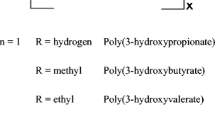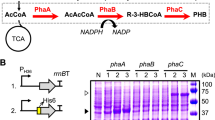Abstract
Poly-hydroxy-butyrate (PHB) bioplastic resin can be made directly from atmospheric CO2 using cyanobacteria. However, higher PHB productivities are required before large-scale production is economically viable. Random mutagenesis offers a way to create new production strains with increased PHB yields and increased biomass densities without complex technical manipulation associated with genetically modified organisms. This study used staining with lipid fluorescent dye (BODIPY 493/593) and fluorescence-activated cell sorting (FACS) to select high lipid content mutants and followed this with a well plate growth screen. Thirteen mutants were selected for flask cultivation and two strains produced significantly higher PHB yields (29% and 26% higher than wild type), biomass accumulation (36% and 33% higher than wild type) and volumetric PHB density (75% and 67% higher than wild type). The maximum PHB yielding strain (% dcw) was 12.0%, which was 43% higher than the wild type (8.3% in this study). The highest volumetric PHB density was 18.8 mg PHB/L compared to 10.7 mg PHB/L by the wild type. To develop cyanobacterial strain with higher PHB productivities, the combination of random chemical mutagenesis and FACS holds great potential to promote cyanobacteria bioplastic production becoming economically viable.








Similar content being viewed by others
Data availability
Datasets can be obtained through emailing the corresponding author.
References
Adwitiya P, Ashwini P, Avinash AK, Badri R, Kajal D, Vomsi P, Srividya S (2009) Mutagenesis of Bacillus thuringiensis IAM 12077 for increasing poly (-β-)hydroxybutyrate (PHB) production. Turk J Biol 33(3):225–230
Bashir SM, Girdhar M, Rehman H, Mohan A (2014) Polyhydroxybutyrate (PHB) production and mutagenesis of halophile isolates from the east african rift salt lake. Biosci, Biotechnol Res Asia 11(3):1273–1282
Bharti SN, Swetha G (2016) Need for bioplastics and role of biopolymer PHB: a short review. J Petrol Environ Biotechnol. https://doi.org/10.4172/2157-7463.1000272
Carpine R, Du W, Olivieri G, Pollio A, Hellingwerf KJ, Marzocchella A, Branco F (2017) Genetic engineering of Synechocystis sp. PCC6803 for poly- β - hydroxybutyrate overproduction. Algal Res 25:117–127
Chaturvedi R, Fujita Y (2006) Isolation of enhanced eicosapentaenoic acid producing mutants of Nannochloropsis oculata ST-6 using ethyl methane sulfonate induced mutagenesis techniques and their characterization at mRNA transcript level. Phycol Res 54(3):208–219
Doan TTY, Obbard JP (2012) Enhanced intracellular lipid in Nannochloropsis sp. via random mutagenesis and flow cytometric cell sorting. Algal Res 1(1):17–21
Flynn T, Ghirardi ML, Seibert M (2002) Accumulation of O2-tolerant phenotypes in H2-producing strains of Chlamydomonas reinhardtii by sequential applications of chemical mutagenesis and selection. Int J Hydrogen Energy 27(11–12):1421–1430
Maddah HA (2016) Polypropylene as a Promising Plastic: A Review. American Journal of Polymer Science 6(1):1–11
Hondo S, Takahashi M, Osanai T, Matsuda M, Hasunuma T, Tazuke A, Nakahira Y, Chohnan S, Hasegawa M, Asayama M (2015) Genetic engineering and metabolite profiling for overproduction of polyhydroxybutyrate in cyanobacteria. J Biosci Bioeng 120(5):510–517
Huesemann MH, Hausmann TS, Bartha R, Aksoy M, Weissman JC, Benemann JR (2009) Biomass productivities in wild type and pigment mutant of cyclotella sp. (Diatom). Appl Biochem Biotechnol 157(3):507–526
Kacmar J, Carlson R, Balogh SJ, Srienc F (2006) Staining and quantification of poly-3-hydroxybutyrate in Saccharomyces cerevisiae and Cupriavidus necator cell populations using automated flow cytometry. Cytometry A 69(1):27–35
Kamravamanesh D, Kovacs T, Pflügl S, Druzhinina I, Kroll P, Lackner M, Herwig C (2018) Increased poly-Β-hydroxybutyrate production from carbon dioxide in randomly mutated cells of cyanobacterial strain Synechocystis sp. PCC 6714: Mutant generation and characterization. Biores Tech 266:34–44
Khan MI, Shin JH, Kim JD (2018) The promising future of microalgae: current status, challenges, and optimization of a sustainable and renewable industry for biofuels, feed, and other products. Microb Cell Fact 17(1):1–21
Khetkorn W, Incharoensakdi A, Lindblad P, Jantaro S (2016) Enhancement of poly-3-hydroxybutyrate production in Synechocystis sp. PCC 6803 by overexpression of its native biosynthetic genes. Biores Technol 214:761–768
Koch M, Bruckmoser J, Scholl J, Hauf W, Rieger B, Forchhammer K (2020) Maximizing PHB content in Synechocystis sp. PCC 6803: a new metabolic engineering strategy based on the regulator PirC. Microb Cell Fact 19(1):1–12
Koch M, Doello S, Gutekunst K, Forchhammer K (2019) PHB is produced from Glycogen turn-over during nitrogen starvation in Synechocystis sp. PCC 6803. Int J Mol Sci 20(8):1942
Krasaesueb N, Promariya A, Raksajit W, Khetkorn W (2021) Inactivation of phosphate regulator (SphU) in cyanobacterium Synechocystis sp. 6803 directly induced acetyl phosphate pathway leading to enhanced PHB level under nitrogen-sufficient condition. J Appl Phycol 33(4):2135–2144
Markl E (2018) PHB - bio based and biodegradable replacement for PP: a review. Novel Techniques Nutr Food Sci 2(5):206–209
Meixner K, Fritz I, Daffert C, Markl K, Fuchs W, Drosg B (2016) Processing recommendations for using low-solids digestate as nutrient solution for poly-ß-hydroxybutyrate production with Synechocystis salina. J Biotechnol 240:61–67
Nielsen TD, Hasselbalch J, Holmberg K, Stripple J (2020) Politics and the plastic crisis: a review throughout the plastic life cycle. Wiley Interdiscip Rev Energy Environ 9(1):1–18
Obruca S, Snajdar O, Svoboda Z, Marova I (2013) Application of random mutagenesis to enhance the production of polyhydroxyalkanoates by Cupriavidus necator H16 on waste frying oil. World J Microbiol Biotechnol 29(12):2417–2428
Price S, Kuzhiumparambil U, Pernice M, Ralph PJ (2020) Cyanobacterial polyhydroxybutyrate for sustainable bioplastic production: critical review and perspectives. J Environ Chem Eng 8(4):104007
Rippka R, Deruelles J, Waterbury JB (1979) Generic assignments, strain histories and properties of pure cultures of cyanobacteria. J Gen Microbiol 111(1):1–61
Rowlands RT (1984) Industrial strain improvement: mutagenesis and random screening procedures. Enzyme Microb Technol 6(1):3–10
Rumin J, Bonnefond H, Saint-Jean B, Rouxel C, Sciandra A, Bernard O, Cadoret JP, Bougaran G (2015) The use of fluorescent Nile red and BODIPY for lipid measurement in microalgae. Biotechnol Biofuels 8(1):1–16
Singhon P, Phoraksa O, Incharoensakdi A, Monshupanee T (2021) Increased bioproduction of glycogen, lipids, and poly(3-hydroxybutyrate) under partial supply of nitrogen and phosphorus by photoautotrophic cyanobacterium Synechocystis sp. PCC 6803. J Appl Phycol 33(5):2833–2843
Takahashi H, Miyake M, Tokiwa Y, Asada Y (1998) Improved accumulation of poly-3-hydroxybutyrate by a recombinant cyanobacterium. Biotech Lett 20(2):183–186
Troschl C, Meixner K, Drosg B (2017) Cyanobacterial PHA production—review of recent advances and a summary of three years’ working experience running a pilot plant. Bioengineering 4(2):26
Wang B, Pugh S, Nielsen DR, Zhang W, Meldrum DR (2013) Engineering cyanobacteria for photosynthetic production of 3-hydroxybutyrate directly from CO2. Metab Eng 16(1):68–77
Wu GF, Shen ZY, Wu QY (2002) Modification of carbon partitioning to enhance PHB production in Synechocystis sp. PCC6803. Enzyme Microbial Tech 30:710–715
Acknowledgements
The authors would like to thank the Australian Government and the University of Technology Sydney for the financial support provided.
Author information
Authors and Affiliations
Corresponding author
Ethics declarations
Conflict of interest
The authors have no financial or non-financial interests directly or indirectly related to the work in this publication.
Additional information
Publisher's Note
Springer Nature remains neutral with regard to jurisdictional claims in published maps and institutional affiliations.
Rights and permissions
Springer Nature or its licensor (e.g. a society or other partner) holds exclusive rights to this article under a publishing agreement with the author(s) or other rightsholder(s); author self-archiving of the accepted manuscript version of this article is solely governed by the terms of such publishing agreement and applicable law.
About this article
Cite this article
Price, S., Kuzhiumparambil, U., Pernice, M. et al. Enhancement of cyanobacterial PHB production using random chemical mutagenesis with detection through FACS. Bioprocess Biosyst Eng 46, 297–306 (2023). https://doi.org/10.1007/s00449-022-02834-5
Received:
Accepted:
Published:
Issue Date:
DOI: https://doi.org/10.1007/s00449-022-02834-5




